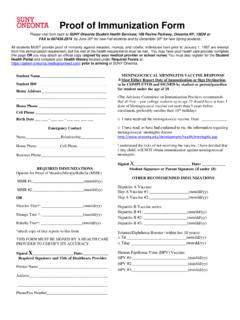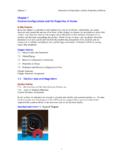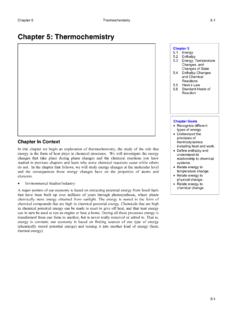Transcription of Chapter 8: Covalent Bonding and Molecular Structure
1 Chapter 8 covalent bonding and molecular structure 8-1 Chapter 8: Covalent Bonding and Molecular Structure Chapter In Context In this Chapter and the next, we examine chemical Bonding in detail. We examined ionic Bonding briefly in Chapter 2 and will do so in more detail in Chapter 11. We will also examine intermolecular forces in detail in Chapter 11. Here we will apply what you have learned about atomic Structure ( Chapter 6), electron configurations, and periodic trends ( Chapter 7) to the chemical bonds formed between atoms and ions and the shapes of molecules and ions that contain Covalent bonds. Biology: Molecular shape of enzymes specifically allow only certain reactions to occur. Drugs are developed that specifically fit into active sites in the enzyme to affect or even stop its action. Chapter Goals Apply Coulomb s Law. Understand forces involved in Covalent Bonding .
2 Write Lewis symbols and Lewis structures. Predict bond properties. Understand charge distribution in molecules. Use VSEPR theory. Identify polar and nopolar species. Chapter 8 Interactions Between Particles: Coulomb s Law Covalent Bonding basics Lewis Structures bond Properties Electron Distribution in Molecules Valence-Shell Electron-Pair Repulsion Theory and Molecular Shape Molecular Polarity Chapter 8 covalent bonding and molecular structure 8-2 Interactions Between Particles: Coulomb s Law OWL Opening Exploration Coulomb s Law Matter is made up of atoms and ions that experience both attractive and repulsive forces. The strength of the force holding oppositely charged particles together in any material is described by Coulomb s Law (equation ). According to this law, force of attraction or repulsion between two charged species is directly proportional to the magnitude of the charge on the particles (qA and qB in equation ) and inversely proportional to the square of the distance between the two particles (r in equation ).
3 Force !(qA)(qB)r2 ( ) For electrons, q = e, and for nuclei, q = +Ze where e = magnitude of electron charge ( x 10 19 C) Z = nuclear charge (number of protons) r = distance between particles A and B All chemical attractive forces involve opposite charges, such as those between protons in a nucleus and the electrons surrounding that nucleus, and between positive and negative ions. The type and strength of these attractive forces allow us to categorize the different types of Bonding found in matter (Table ). In ionic Bonding , found in ionic solids and liquids such as NaCl and CaCO3, there are strong attractive forces between positively and negatively charged ions. Covalent Bonding , the attractive forces between electrons and nuclei on adjacent atoms within a molecule, occurs in compounds such as H2O and NH3. Another type of attraction takes place in pure metals. Metallic Bonding , the attractive forces between electrons and nuclei in metals, occurs in metals such as Cu and Fe and will be discussed in more detail in Chapter 9.
4 Finally, there are forces that exist between molecules, called intermolecular forces, which will be discussed in more detail in Chapter XX. Table Types of Chemical Bonding Type of Interaction Source of Attractive Forces Ionic Bonding Oppositely charged ions Covalent Bonding Nuclei and valence electrons Metallic Bonding Nuclei and electrons Intermolecular Forces Partial charges on individual, separate molecules Covalent Bonding basics OWL Opening Exploration A Covalent bond is characterized by the sharing of valence electrons by two adjacent atoms. This happens most often between nonmetal elements such as carbon, hydrogen, oxygen and nitrogen. For example, consider a simple covalently bonded molecule, H2. When two isolated H atoms are at a great distance from one another, they feel no attractive or repulsive forces. However, as the atoms approach more closely, the attractive and repulsive forces between the two atoms become important.
5 Chapter Goals Revisited Apply Coulomb s Law Understand relationship between charge, distance, and force of attraction or repulsion. Chapter Goals Revisited Understand forces involved in Covalent Bonding . Identify attractive and repulsive forces between atoms. Chapter 8 covalent bonding and molecular structure 8-3 There are two types of repulsive forces between the two atoms. First, the nuclei repel because they are both positively charged. Second, the electrons repel because they are both negatively charged. The attractive forces between the two atoms result from the interaction between the positively charged nucleus on one hydrogen atom and the negatively charged electron on the other hydrogen atom. In summary, for two hydrogen atoms, HA and HB, Repulsive Forces: electron A electron B nucleus A nucleus B Attractive Forces: electron A nucleus B electron B nucleus A In general, when two atoms approach each other, these repulsive and attractive forces always occur.
6 When the attractive forces are greater than the repulsive forces, a Covalent bond forms. When the repulsive forces are greater than the attractive forces, a Covalent bond does not form and the atoms remain isolated. The balance between the attractive and repulsive forces in H2 is related to the distance between H atoms, as shown in Figure At large distances, neither attractive nor repulsive forces are important and no bond forms between H atoms. At short distances, repulsive forces are stronger than attractive forces and no bond forms. Figure Energy of H2 as a function of internuclear distance At an internuclear distance where the attractive forces are stronger than the repulsive forces, a bond forms between the H atoms. The two valence electrons pair up and are shared between the two hydrogen nuclei in a Covalent bond that is represented by a single line connecting the H atoms.
7 H + H H H The single line between H atoms in H2 is a very useful representation of a chemical bond , but it is does not give an accurate picture of the distribution of Bonding electrons in the Hrepresents nucleusrepresents valence electronFlashforward Molecular Orbital Theory Chapter 8 covalent bonding and molecular structure 8-4 H2 molecule. More sophisticated descriptions of chemical Bonding will be discussed in Chapter 9. Lewis Structures OWL Opening Exploration One of the most important tools chemists use to predict the properties of a chemical species is its Lewis Structure . A Lewis Structure (also called a Lewis dot Structure or Lewis diagram) shows the arrangement of valence electrons (both Bonding and nonbonding) and nuclei in covalently bonded molecules and ions. The simplest Lewis Structure is the Lewis symbol for an element, where the element symbol represents the nucleus and core (non-valence) electrons, and dots represent valence electrons.
8 As shown in the Lewis symbols in Figure , valence electrons are traditionally arranged around the four sides of the element symbol. The electrons are single or paired to reflect the electron configuration of the element and the Pauli exclusion principle. Figure Lewis symbols for the 2nd period elements. The Lewis symbols for the elements in the 2nd period (Figure ) show the relationship between valence electrons and group number for the A group (main group) elements. Recall that the number of valence electrons for any main group element is equal to the group number for that element. EXAMPLE PROBLEM: Lewis Symbols for Atoms (a) Draw the Lewis symbol for Te, tellurium. (b) The following Lewis diagram represents the valence electron configuration of a main-group element. Identify the element in period 5 that has this valence electron configuration. SOLUTION: (a) Te Tellurium is a Group 6A element and has six valence electrons.
9 (b) Rb The element has one valence electron, so it is a Group 1A element. Rubidium is the Group 1A element in the fifth period. OWL Example Problems Lewis Symbols for Atoms The representation of H2 shown in the previous section where the Bonding electron are represented with a line, H H, is the Lewis Structure of H2. In a Lewis Structure , pairs of Bonding electrons are represented as lines connecting atom symbols, and nonbonding electrons are shown as dots (Figure ). Nuclei and core electrons are represented by element symbols. Notice in Figure that there can be more than one Bonding pair between atoms, and that nonbonding electrons usually appear in pairs (called lone electron pairs or lone pairs). A bond consisting of two electrons (one line) is called a single bond , a bond made up of 4 electrons (two pairs, two lines) is called a double bond , and a bond with 6 electrons (three pairs, three lines) is called a triple bond .
10 Chapter Goals Revisited Write Lewis symbols and Lewis structures. Use the periodic table and valence electrons to write Lewis symbols. Flashback Electron Configuration of Elements Chapter 8 covalent bonding and molecular structure 8-5 Figure Lewis structures for C2H4 and ICl. Lewis structures are very useful in visualizing the physical and chemical properties of compounds made up of nonmetal elements. We will begin by learning how to create Lewis dot structures, and then in the following sections use Lewis structures to explore bond properties ( bond order, bond length, bond energy, bond polarity), the shapes of molecules, Molecular polarity, and how the shape and polarity of molecules influence chemical properties. Drawing Lewis Structures The most important guideline to follow when drawing Lewis structures is the octet rule.



















